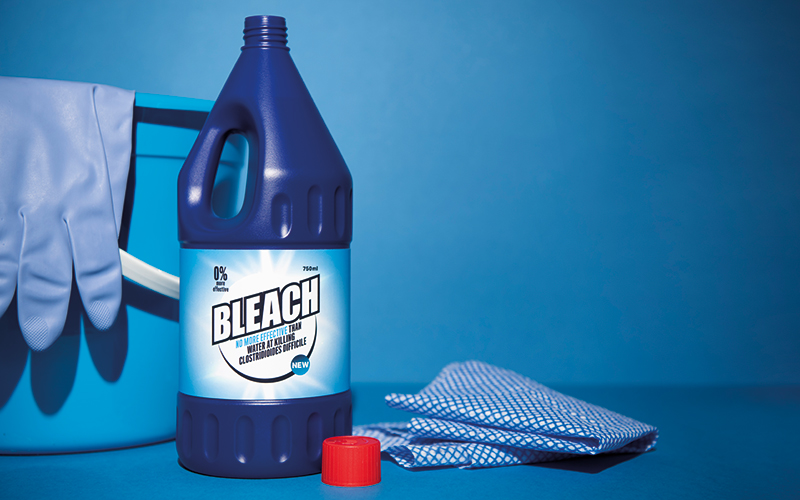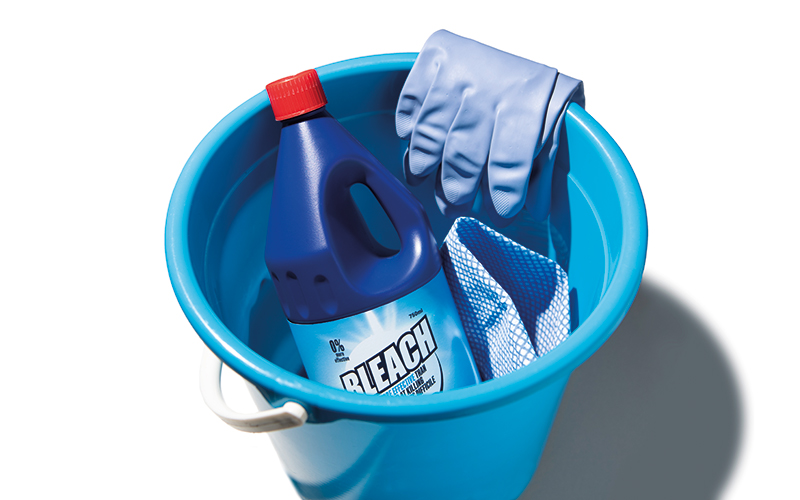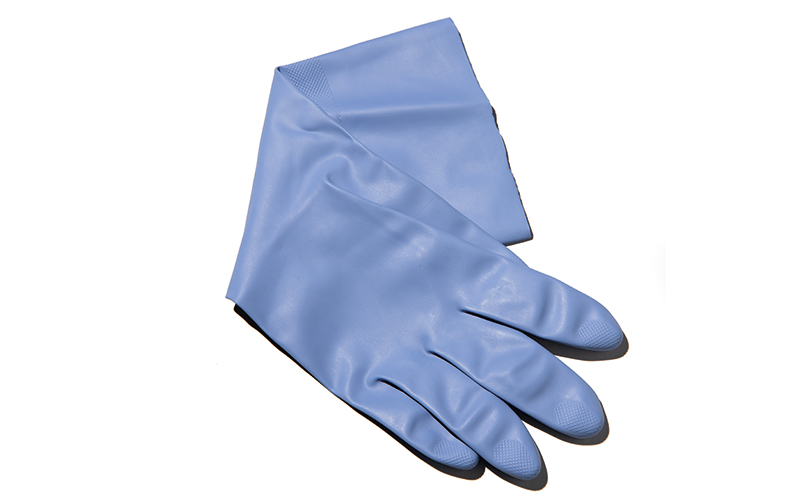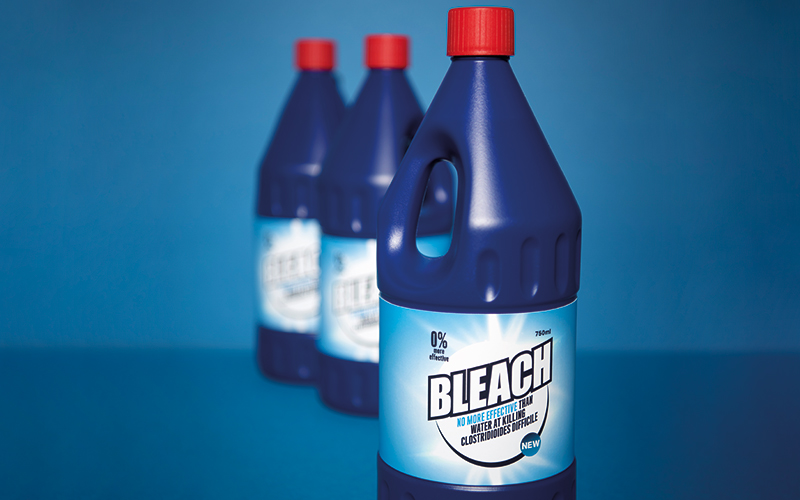Following the publication of a paper that shows bleach is ineffective at killing Clostridioides difficile, we look back over the history of antimicrobial resistance, discuss current infection control measures and ask whether increasing resistance is the most serious crisis facing humanity.

The spread of antimicrobial resistance (AMR) threatens to undermine one of the foundation pillars of modern healthcare – infection control.
Since Alexander Fleming stumbled upon the antibacterial properties of the fungus that he christened “pencillin” in 1928, the subsequent development of antibiotics, antivirals, antifungals and antiparasitics has underpinned most of the medical advances seen around the world. From treating common infections, such as athlete’s foot, to performing complex procedures, such as heart transplants, none of it would be possible without the various antimicrobials that can check and defeat the many potential infectious agents waiting to invade susceptible human bodies.
But like all other living organisms, microbes evolve. Over time they alter their genetic make-up to better fit the changing environments in which they live. It’s a wholly natural process. However, the overuse and misuse of antimicrobials in humans and animals has given microbes the opportunity to evolve more rapidly. Any that survive a course of treatment become the dominant strain, gradually developing strong resistance to existing antimicrobials and potentially causing infections that are difficult, or even impossible, to treat.
Scale of the problem
A Lancet article published in 2022, “Global burden of bacterial antimicrobial resistance in 2109: a systematic anaylsis”, estimated the current scale of the problem. It suggested that bacterial AMR alone directly caused almost 1.3 million deaths around the world in 2019 and was a contributory factor in nearly 5 million more.
According to WHO’s Global antimicrobial resistance and use surveillance system (GLASS) report: 2022, which tracks the rise of drug-resistant bacteria around the world, the median rate of resistance among Escherichia coli to the usual antibiotic was 42% and for Staphylococcus aureus the figure was 35%.
The UN Interagency Coordination Group on Antimicrobial Resistance suggests that if this trajectory persists, AMR could be responsible for 10 million deaths a year by 2050.
“Bleach is ineffective”
The depth of the creeping problem of AMR was underscored further in November with the publication in the journal Microbiology of the article “Clostridioides difficile spores tolerate disinfection with sodium hypochlorite disinfectant and remain viable within surgical scrubs and gown fabrics”.
The findings are all there in the title: bleach is ineffective at killing “C. diff”, one of the so-called superbugs that plague modern hospitals.
The researchers transferred C. diff spores to surgical scrubs and patient gowns and then exposed them to varying concentrations of sodium hypochlorite for 10 minutes. After this disinfection attempt they found that viable spores could still be found on the fabrics. The research concluded that “alternative strategies should be urgently sought to disinfect C. diff spores to break the chain of transmission in clinical environments”.
One of the authors of the article is Dr Tina Joshi, Associate Professor of Molecular Microbiology at the University of Plymouth. “This has been a build-up of years of work,” she says. “It’s not trying to prove that sodium hyprochlorite doesn’t work. It’s saying that we’ve underestimated the situation.
We’ve overused certain biocides in the healthcare environments.
And what’s happened is that some of these spores may be showing resistance and tolerance at a level we’ve never thought before.”
The research raises a fundamental question about the use of biocides and their role as antimicrobials in hospitals and clinics. “Are we using them at the right time and at the right concentration for the right microorganism?” asks Joshi. “It doesn’t appear that we are.”
AMR history and recent data
Antibiotics and antimicrobial resistance – a timeline
- 1900 The search for chemicals with antibiotics begins
- 1928 Penicillin discovered
- 1933 Antibiotics used in animals
- 1943 Penicillin approved for clinical use in humans
- 1943 Streptomycin discovered
- 1950 Antibiotics used to promote animal growth
- 1960 Antibiotics used to increase global food production
- 1986 Methicillin resistance identified in Staphylococcus aureus
- 1990 Resistance to different antibiotics continues to emerge
- 1997 Some countries start to restrict use of growth-promoting antibiotics
- 2015 Antimicrobial resistance is declared a global emergency by the WHO.
Latest data from the UK Health and Security Agency shows that in 2022:
- Resistant infections rose by 4% after decreasing during the pandemic
- E. coli was responsible for 82% of antibiotic-resistant bloodstream infections (BSIs)
- Rates of resistant BSIs remain below those in 2018, despite rebounding from pandemic lows
- Prescribing of antibiotics in England increased after years of decline. Total prescribing increasing by 8.4% compared with 2021. Overall use remains below pre-pandemic levels
- Among the white ethnic group, about 19% of BSIs were resistant to at least one key antibiotic. Among the Asian or Asian British ethnic group, almost 35% of BSIs showed resistance.
We need to intervene
Francis Yongblah, Senior Biomedical Scientist at Great Ormond Street Hospital for Children NHS Foundation, agrees that the results are concerning. “Obviously cleaning is key in terms of what we are doing trying to prevent transmission within the wards, especially with C. diff because it sporulates. We need to intervene with the correct cleaning methods.”
For Phillipa Burns, Consultant Clinical Scientist at Hull and East Yorkshire Hospitals NHS Trust, the results of Joshi’s research did not come as a huge surprise. “We moved to sporicidal cleaning agents a long time ago. When I first started working in microbiology we used bleach, but for some time now we’ve used non-hyprochlorite-based cleaning agents. You need to be able to deep clean with it and have some assurance that your laboratory environment is free from the risk of contamination with fungal spores.”
At Great Ormond Street, as with most other hospitals, methicillin-resistant S. aureus (MRSA) is one of the big threats. “We also look for vancomycin-resistant enterococci (VRE) and Pseudomonas aeruginosa, which is one more for the intensive care unit wards,” says Yongblah. “Then there is Enterobacter and Klebsiella. They are key ones we look for within our patient demographic, but there are lots of others.” Depending on the pathogen, the cleaning regimen involves three levels of intensity and different agents.
A deeper issue
Beyond conversations about the most appropriate cleaning approaches, the research shines an intense light on the deeper issue. “AMR is perhaps the most serious crisis facing humanity,” says Joshi. “I think it might be bigger than climate change because antimicrobials underpin the whole of modern medicine. As scientists we have perhaps sanitised the message so that we don’t induce fear in the public. But when I think about it, it keeps me up at night because I’m worried that we don’t have solutions.”
One of the key solutions would be the development of new antibiotics – but this is not happening. “People are trying to develop new antibiotics, but there’s little economic support for them,” says Joshi. “Big pharma is reluctant to take them on because they don’t generate enough profit. The blockbuster drugs for arthritis and diabetes, you’ll need those for the rest of your life. But you only need an antibiotic for five days.”
Burns agrees: “It’s a hostile market for anybody who needs to make money back on their investment in a short window of time before it goes off license.” The result is an antibiotic pipeline that simply isn’t flowing.
Another critical area where new developments are lacking is diagnostics. Prescribing the right drug depends on diagnosing the infection quickly and accurately. That way, outcomes for patients would be better and one of the main drivers of AMR – inappropriate use of antibiotics – would be reduced.
But precise diagnostics that offer rapid results at a reasonable cost are hard to come by. “A diagnostics pipeline also needs to exist,” says Joshi. “But, again, the problem is that there’s no market for it.”
Estimates from systematic analysis
The Global burden of bacterial antimicrobial resistance in 2019: a systematic analysis published a range of estimates, including:
- AMR-associated lower respiratory infections accounted for more than 1.5m deaths
- The six leading pathogens for deaths associated with AMR are E. coli, S. aureus, K. pneumoniae, S. pneumoniae, A. baumannii, and P. aeruginosa associated with AMR
- Methicillin-resistant S. aureus, caused more than 100, 000 deaths attributable to AMR, while six other drug-resistant pathogens each caused 50 ,000 to 100 ,000 deaths.

In the absence of new antibiotics and effective diagnostics, antimicrobial stewardship takes on a more critical role. This entails a hospital or other healthcare system using its antimicrobial resources with care and precision, helping to ensure they remain viable for years to come.
Stewardship is one of the central components of the UK Government’s five-year action plan, Tackling antimicrobial resistance 2019-2024, which is itself part of a longer-term drive to contain and control AMR by 2040. Though progress is being made towards this goal, much work remains.
A further strand to controlling AMR is robust and widespread surveillance of infection and antimicrobial use. “One of the things that we did so well for COVID was surveillance,” says Joshi. “We were sequencing all the time and knew what variants were coming. We need something similar for AMR. We need to know what new bugs are coming and the best way to treat them.”
Working in the same direction

Laboratory capacity is a key issue here. The pressures on microbiology services show few signs of easing, so the demands of AMR have to be handled at the same time and in the same place as all the competing needs. Related to this is the standardisation of processes and data collection and usage. “Is each lab doing the same thing?” asks Yongblah. “Is everyone working in the same direction? I think that’s key if we’re to identify and find ways to deal with infections quickly.”
Burns says that procedures in hospitals could be more thorough. “Are we closing the loop down with infections? We provide personalised treatment and care to get the individual over their infection, but how often do we look back at where this infection came from? Was the environment the reservoir? Was the environment clean enough? Did the individual bring this organism into the hospital? I’m not sure if we are consistent with that. Do we have that time and energy to undertake environmental monitoring screening and really understand how this infection happened?”
Genomic sequencing
While the monitoring of key pathogens in the laboratory in a standardised way would be a step in the right direction, genome sequencing would offer a much bigger leap. Unlike novel antibiotics or diagnostics, the technology for that is to hand and would allow the sequencing that could yield a much deeper understanding of the bacteria and other pathogens that can cause serious infections in patients.

“We know that when we give antibiotics, bacteria may start to express that resistance gene,” says Burns. “If we understood the bacteria at a genomic level in real time, that could guide our antibiotic treatment options better. We would know what it’s expressing, what it has the potential to express. It could also inform our infection control policies and maybe better influence our stewardship policies. We have to start adopting technology that would allow us as scientists to do our own surveillance and have our own understanding of what is going on in our own hospitals. We have to be able to see how the pieces of the puzzle fit together.”
“The best infection is no infection at all. If hospitals are being cleaned properly, there will be no spread”

Priorities to address AMR in human health
AMR is one of the threats to global health being addressed under WHO’s integrated One Health initiative. This promotes the wellbeing of people, animals and the environment by identifying problems, tackling the root causes and creating sustainable solutions. According to WHO, the priorities to address AMR in human health are:
- Preventing infections that may result in inappropriate use of antimicrobials
- Universal access to quality diagnosis and appropriate treatment
- Strategic information – e.g. surveillance of AMR and antimicrobial use
- Research and development for vaccines, diagnostics and medicines.
A stark warning
It is not only bacteria that need much closer analysis. The story of the yeast species Candida auris offers a stark warning. First encountered in 2009 it has since caused serious infections in patients around the world, affecting the bloodstream, internal organs and central nervous system. More worrying, C. auris is resistant to all frontline antifungals, such as fluconazole. The origins of the fungus remain speculative.
For Tina Joshi, the first line of defence against AMR comes back to infection prevention and control. “The number one method to get rid of an infection is cleaning and disinfection based on bioscience,” she says. “The best infection is no infection at all. If hospitals are being cleaned properly, there will be no spread. But if biocides are being misused or overused, they can cause selective pressure. We need to use our disinfectants properly. If we’re not, it is going to cause more of an issue.”
Francis Yongblah agrees that infection control is pivotal. “If we want to run services and to keep patients safe, we must prevent AMR. Bugs evolve at a rapid rate as does the transfer of genes,” he says. “Without the correct precautions, there’s always the possibility of infection.”
Phillipa Burns adds that she knows from her own experience that C. diff can be difficult to kill. “Tina Joshi’s paper has shown that we should be using sporicidal agents to wash fabrics that patients come into contact with.”
The focus, says Joshi, must be on using the resources that we have available both carefully and wisely. “What we’ve got is quite precious. The existing antimicrobials are precious. We don’t want the bugs to become fully resistant to them in our lifetime. AMR is an absolutely huge issue and there’s no single solution. But one of the best ways to stop AMR is disinfection surveillance.”
Image credit | Richard-Gleed
